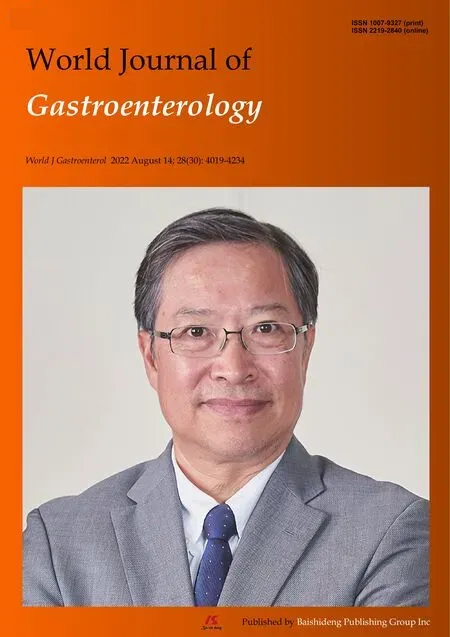Alcohol-related diseases and liver metastasis: Role of cell-free network communication
Manuel Muro,Aurelia Collados-Ros,Isabel Legaz
Abstract Alcohol intake is a risk factor for cancer development and metastatic disease progression. Extracellular vesicle (EV)-mediated interorgan communication is assumed to be significant in boosting tumorigenic pathways and disease progression. Recent research indicates that exosomes have a variety of roles in the development of cancer during pathophysiological conditions. The involvement of EV signaling during cancer progression in the alcohol environment is unknown.Therefore, understanding communication networks and the role of EVs as biomarkers can contribute significantly to developing strategies to address the serious public health problems associated with alcohol consumption and cancer.
Key Words: Exosomes; Liver metastasis; Alcohol-associated liver disease; Cancer
TO THE EDlTOR
We have read with great attention and particular interest the review by Kurachaet al[1] entitled: “Role of cell-free network communication in alcohol-associated disorders and liver metastasis”. The authors highlight the many implications of extracellular vesicle (EV) (exosome) communications across organs in this review, focusing on the role of EVs in alcohol-related illnesses and cancer metastasis. It is crucial to consider the impact of EV cargo and release along a multi-organ axis on tumorigenic pathways and metastatic disease.
Alcohol consumption negatively impacts people’s health and quality of life, contributing to more than 5% of the global disease burden and early death[2,3]. Alcohol intake has been linked to several neoplastic diseases, including colorectal, head and neck, esophageal, liver, breast, and pancreatic cancers[4,5]. On the other hand, recent research suggests that exosomes have different functions in disease progression during pathophysiological circumstances. Exosomes from tumors have been found to operate as regulatory factors in cancer development, promoting cell migration and proliferation and creating a pre-metastatic niche for cells resistant to treatment[6,7].
Hepatocytes and non-parenchymal cells produce and release EVs at higher rates in response to alcohol-mediated stress[8]. The EVs produced can alter gene expression and target cell function,prolonging liver damage[8]. Bidirectional exosomal communication between organs, including the liver,brain, intestine, and lungs, can also happen in addition to intra-organ transmission mediated by EVs.The gut-liver axis maintains bilateral interactions in an environment where alcohol is present, which results in gut dysbiosis and the progression of liver impairment[9,10].
In addition to persistent alcoholism, endotoxin transfer during sepsis and brain inflammation are caused by loss of intestinal barrier integrity. Alcohol dependency and its regulatory consequences, such as altered immunological function and neurological and endocrine signaling, are hypothesized to be influenced by alcohol-induced gut dysbiosis[11,12]. Acute respiratory distress syndrome, bacterial infection, and hepatopulmonary syndrome are also linked to persistent alcohol exposure on the liverlung axis (ARDS)[13,14].
The significance of alcohol-induced EV communication in cancer initiation and progression is unknown until now because of the high prevalence of alcohol drinking and cancer-related risk. The therapeutic significance of the function of these exosomes has been highlighted by identifying EVs as critical mediators of communication networks within and across organ systems[7,15,16]. Clinical evaluation of EVs in body fluids provides another measure for understanding exosomes as valid and valuable diagnostic biomarkers and therapeutic targets.
Communication between malignant and non-cancerous cells, mediated by nanometric vesicles, is thought to be an essential part of tumor growth and its subsequent spread through the body. By promoting oncogene overexpression, stromal cell remodeling, immune system regulation, and angiogenesis, tumor-derived exosomes may control the course of cancer[17]. Cancer cells’ ability to grow anchorage-independently is thought to be enhanced, and their morphological changes may be modulated by the transfer of tumor-causing material through EVs[18].
Additionally, miRNA-enriched EVs have also been demonstrated in cell-cell communications and the conversion of cells into populations with enhanced motility[19]. The involvement of EV signaling during cancer progression in the alcohol environment is unknown. Recent studies have shown that the exosomal content (proteins, miRNA, non-coding RNA) can help diagnose and treat cancer[20-22].Therefore, comprehending EVs and communication networks as biomarkers can considerably aid in developing methods to deal with the serious public health issues brought on by alcohol intake and cancer.
FOOTNOTES
Author contributions:Legaz I contrubited to conceptualization; Muro M, Collados-Ros A, and Legaz I contrubited to writing-original draft preparation; Muro M and Legaz I contrubited to writing-review and editing, writing-original draft preparation, supervision, and writing-review and editing; all authors read and approved the final manuscript,read and approved the final manuscript.
Conflict-of-interest statement:There are no conflicts of interest to report.
Open-Access:This article is an open-access article that was selected by an in-house editor and fully peer-reviewed by external reviewers. It is distributed in accordance with the Creative Commons Attribution NonCommercial (CC BYNC 4.0) license, which permits others to distribute, remix, adapt, build upon this work non-commercially, and license their derivative works on different terms, provided the original work is properly cited and the use is noncommercial. See: https://creativecommons.org/Licenses/by-nc/4.0/
Country/Territory of origin:Spain
ORClD number:Manuel Muro 0000-0001-9987-0994; Isabel Legaz 0000-0002-1140-4313.
S-Editor:Chen YL
L-Editor:A
P-Editor:Chen YL
 World Journal of Gastroenterology2022年30期
World Journal of Gastroenterology2022年30期
- World Journal of Gastroenterology的其它文章
- Benefits of minimally invasive surgery in the treatment of gastric cancer
- Contrast-enhanced ultrasound of a traumatic neuroma of the extrahepatic bile duct: A case report and review of literature
- ANGPT: Angiopoietin; VEGFA: Vascular endothelial growth factor; PGF: Placental growth factor; AFP: Alpha-fetoprotein; IQR: Interquartile range; SD:Standard deviation, SE: Standard error.
- Network meta-analysis of randomized controlled trials on esophagectomies in esophageal cancer: The superiority of minimally invasive surgery
- Hepatocellular carcinoma, decompensation, and mortality based on hepatitis C treatment: A prospective cohort study
- Epidemiology of inflammatory bowel diseases in the state of Rio Grande do Sul, Brazil
